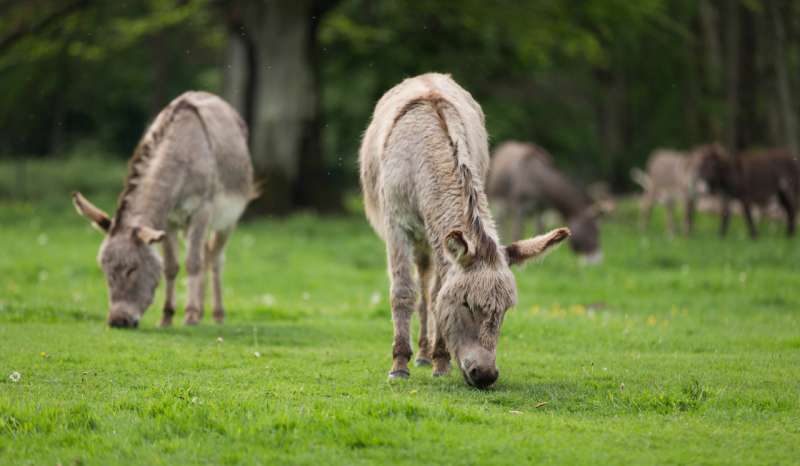Domestic donkey in the mist. Knuthenborg Safari Park, Denmark. Credit: Copenhagen Zoo/Frank Rønsholt
A team of researchers from Denmark, Malaysia, France and the U.K. has conducted a genome assembly of the donkey to learn more about its evolutionary history. In their paper published on the open access site Science Advances, the group describes their study and what they found.
While the horse is well recognized by most people, the same cannot be said for the lowly donkey. This is likely due to some confusion regarding how it fits in with other horse-like animals. Scientifically speaking, the donkey is one of many of the asses. Mating a donkey with a horse can result in the birth of a mule (from a male donkey and a female horse) or a hinny (a female donkey and a male horse). As the researchers with this new effort note, a lot of genetic research has been done on the horse, but very little on the donkey. They have sought to rectify that situation by conducting a high-quality genome assembly of the donkey genome.
As part of their effort, the researchers created scaffolds, which are spans of genetic details, that are a factor of four higher than any other previous effort with donkeys. The amount of data was massive, filling 10 megabytes. But it also revealed a lot about donkeys, such as their history, including their split from the group that now includes the modern horse, going back approximately 4 million years. They also observed chromosomal rearrangements such as translocations and inversions, which will reveal more about how the donkey species diverged and separated from others.
Both horses and donkeys belong to the equid family, which prior research has shown have been around for approximately 55 million years. But today, the researchers note, just one member of the family remains, Equus. It includes both horses and donkeys, and also three kinds of zebras and other ass species. Asses, notably, split off from others in the family nearly two million years ago—the new sequencing results push the accepted date back approximately 200,000 years. Donkeys, the researchers note, were domesticated approximately 5,000 years ago.
More information: Gabriel Renaud et al. Improved de novo genomic assembly for the domestic donkey, Science Advances (2018). DOI: 10.1126/sciadv.aaq0392
Abstract
Donkeys and horses share a common ancestor dating back to about 4 million years ago. Although a high-quality genome assembly at the chromosomal level is available for the horse, current assemblies available for the donkey are limited to moderately sized scaffolds. The absence of a better-quality assembly for the donkey has hampered studies involving the characterization of patterns of genetic variation at the genome-wide scale. These range from the application of genomic tools to selective breeding and conservation to the more fundamental characterization of the genomic loci underlying speciation and domestication. We present a new high-quality donkey genome assembly obtained using the Chicago HiRise assembly technology, providing scaffolds of subchromosomal size. We make use of this new assembly to obtain more accurate measures of heterozygosity for equine species other than the horse, both genome-wide and locally, and to detect runs of homozygosity potentially pertaining to positive selection in domestic donkeys. Finally, this new assembly allowed us to identify fine-scale chromosomal rearrangements between the horse and the donkey that likely played an active role in their divergence and, ultimately, speciation.
Journal information: Science Advances
© 2018 Phys.org























